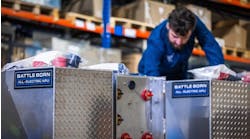PRINCETON, NJ. The U.S. economy is still growing, albeit more slowly, and freight volumes look to stay steady for the rest of this year and into 2016, noted Noel Perry, senior consultant with FTR Transportation Intelligence and principal of research firm Transport Fundamentals.
But beyond 2016, he thinks fleets should “think about going in the bunker” as sovereign debt issues could finally catch up to many developed countries, including the U.S.
Near term, though, the outlook looks pretty good for trucking, Perry stressed.
“The U.S. economy continues its slow recovery and GDP [gross domestic product] should grow 2.3%,” he said. “This has also been a strong truck freight recovery and I expect truck freight growth to continue, reaching 3.2% in 2016.”
Perry characterized his outlook as “a decent forecast but not as strong as before.” He noted that sovereign debt is a major unspoken issue hanging over many countries, especially the U.S. and its European trading partners.
“That is the major downside risk for 2017-2018,” Perry said. “Sovereign debt is a difficult problem to solve and at some point banks are just not going to lend. That is the major exposure for the next five years.”
In terms of trucking-specific issues, he believes regulatory drag is to blame for much of the capacity issues faced by the industry – especially helping to eliminate “surge capacity,” which makes the industry now especially vulnerable to seasonal demand and weather.
“In short, government is making trucking less productive, though that may be good public policy,” he said. “That’s why now is the time for ‘big thinking’ as the industry undergoes major structural changes.”
The suspension of the 34-hour restart rule, however, has eased the truck capacity crunch to a degree this year. Perry stressed that, as a result, the industry needs to use the next two years to learn the lessons from the tight capacity situation experienced in 2014.
Looking forward, Perry believes the trucking industry will experience what he terms “a second revolution” due to technology – especially where autonomous vehicle technology is concerned. “If the regulatory side is managed properly, we may see this technology arrive as early as 2020,” he said.
Last but not least, Perry stressed that the rapid development of U.S. shale oil has effectively eliminated “oil crisis” worries regarding petroleum shortages for the foreseeable future.
“Though fuel prices are on the way back up, the concept of an ‘oil crisis’ is effectively over,” he explained.



